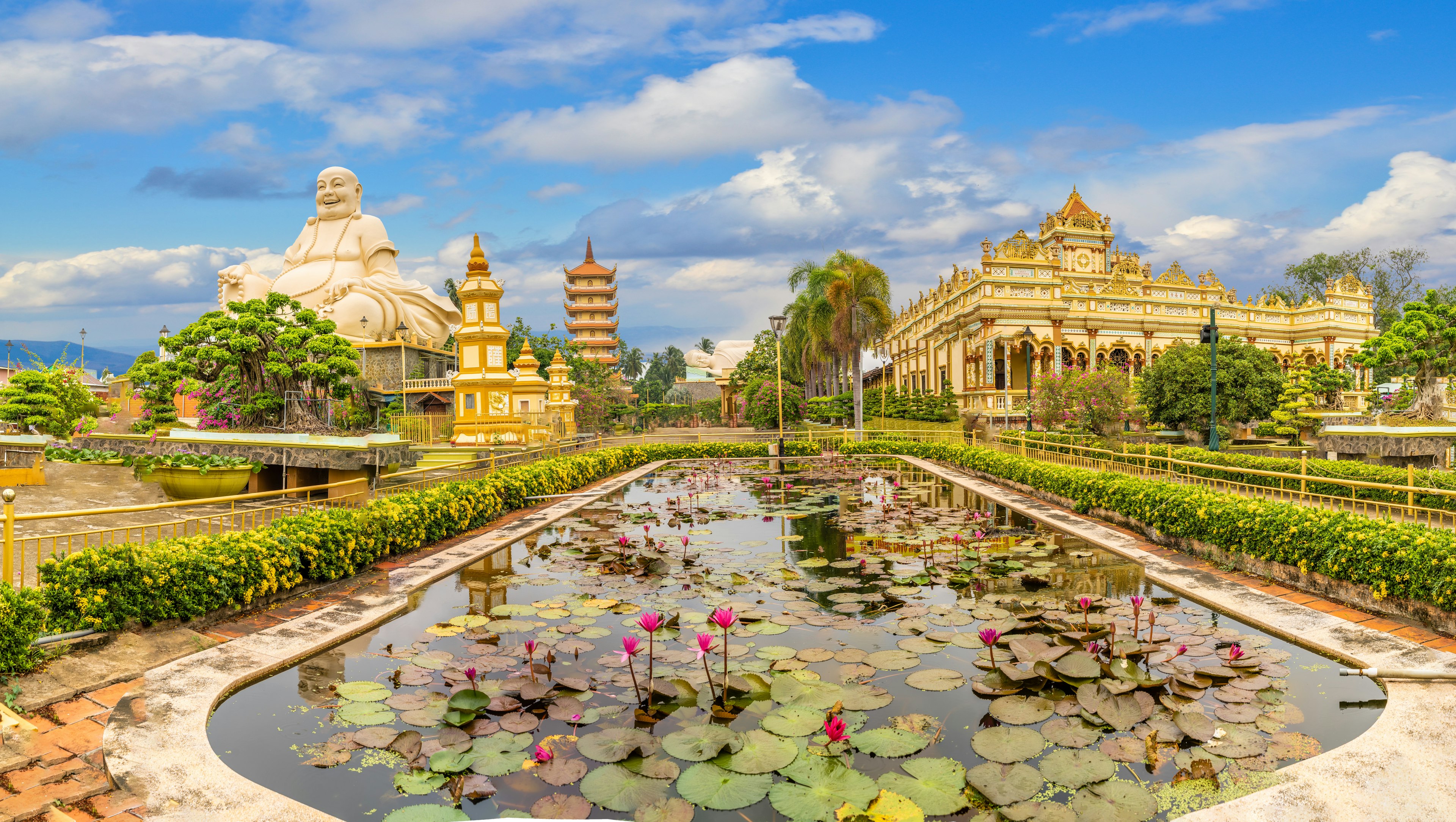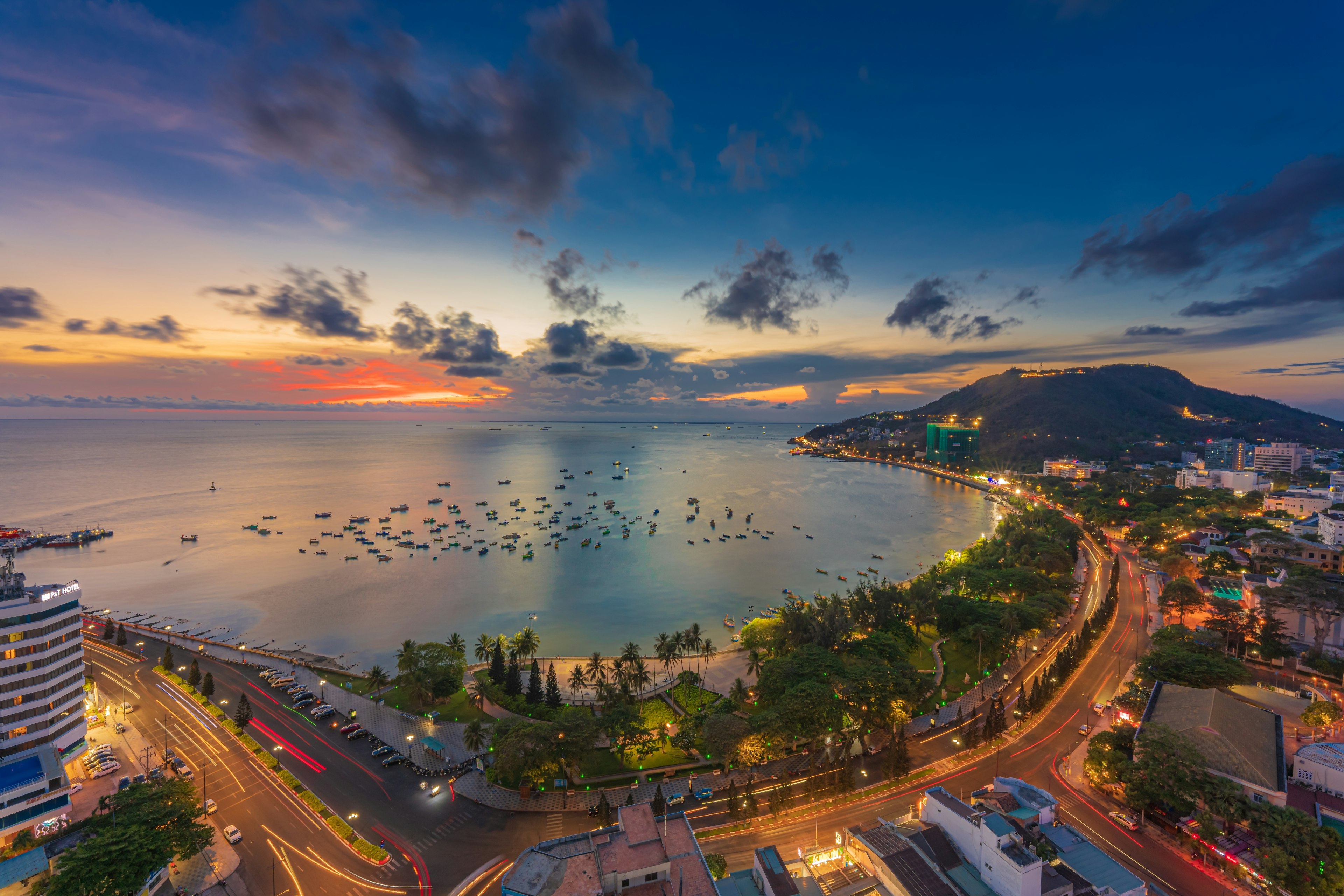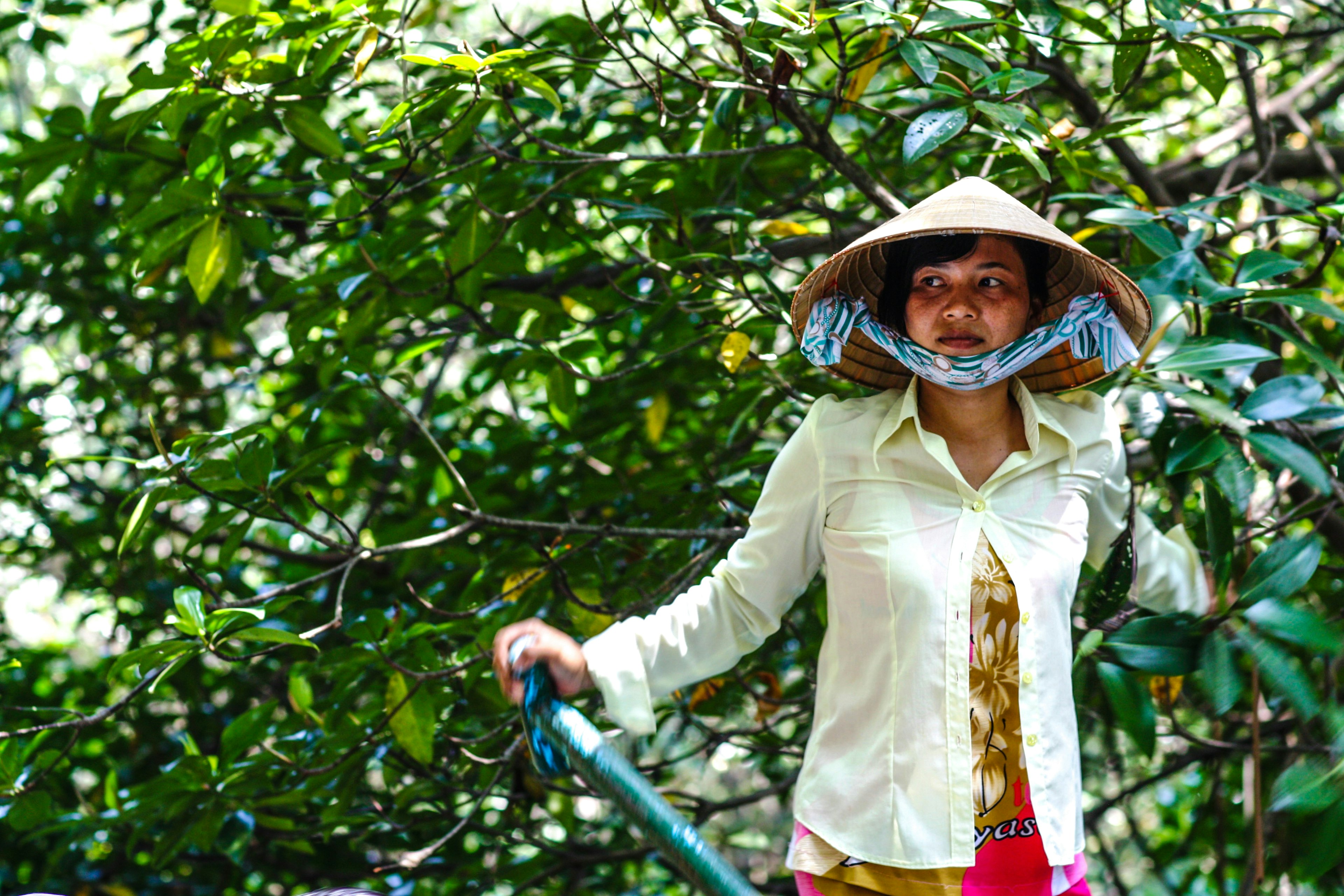

The green waterways of the Mekong Delta can be easily explored on day trips from Ho Chi Minh City. ImaginativeGifts / Shutterstock
Vietnam's largest city, Ho Chi Minh City (HCMC) – also known as Saigon – is the gateway to the steamy southern reaches of this slender Southeast Asian nation. HCMC is celebrated for its vibrant nightlife, spectacular dining, rich history and French-era architecture. It's easy to while away happy days slurping down amazing noodle soups and walking along century-old streets laid down during the Indochina era.
But Ho Chi Minh City is also the front door to southern Vietnam and the vast, waterlogged Mekong Delta, with its colorful markets, wartime relics and pristine nature reserves. Bus routes crisscross the countryside around Vietnam's southern capital and tour agencies offer all sorts of itineraries, making for easy detours. Here’s our pick of the best day trips from Ho Chi Minh City.

1. Get a taste of the Vietnamese countryside at Ben Tre and My Tho
Travel time: 2 hours
If you don’t have time for an overnight trip to the Mekong Delta, these two sister cities just two hours south of Ho Chi Minh City provide a rewarding glimpse of southern country life. Ben Tre, the so-called Coconut Capital of Vietnam, lies across the Mekong River from the more developed city of My Tho. Both make for a quaint getaway based around fruit orchards, local pagodas, intriguing cottage industries and detours to surprisingly rural villages off the main highway.
The four inhabited river islands between Ben Tre and My Tho are home to bee farms, coconut candy factories and scenic orchards where you can sample tropical fruit while being serenaded by Vietnamese folk singers. Explore on boat tours with companies such as Mango Cruises or tourist boat operators at My Tho. The Vietnamese government has established several eco-resorts in the area, complete with horse-pulled carts that take visitors from attraction to attraction.
Ben Tre makes everything imaginable from the humble coconut, from coconut wood souvenirs to chewy coconut candy. You can watch as workers stretch and mold the sweet little squares and take some home as a memento. Also try the noodle soup known as hủ tiếu Mỹ Tho, a specialty of My Tho, with chewy rice noodles topped with shrimp, pork, pork offal and heaps of fresh vegetables. If you visit My Tho, don't miss the striking Vinh Trang Pagoda, about 1km (0.6 miles) east of the center, with its looming Buddha statue.
15 best things to do in Ho Chi Minh City
How to get to Ben Tre and My Tho from HCMC:
If you’re confident on a motorcycle, head two hours due south from Ho Chi Minh City on the Quoc lo 1A. With your own wheels, you’ll be free to veer off onto the many small lanes leading to village markets and authentic countryside scenes completely devoid of tourists. Otherwise, join better-off locals and take one of the comfortable air-conditioned private buses and mini-vans for the two-hour road trip to Ben Tre (from VND90,000).
In both My Tho and Ben Tre, you can arrange a boat and guide to visit the islands. Easier still are organized day trips from HCMC, which can be booked through guesthouses and travel agencies for as little as US$20, including lunch.

2. Lie out in style at Vung Tau’s beaches and hotels
Travel time: 2 hours
Known as Cap Saint-Jacques when it was a beach playground frequented by French colonialists, modern-day Vung Tau has the closest ocean beaches to Saigon. While its long list of attractions includes a giant statue of Jesus (even larger than the one in Rio), a turn-of-the-century lighthouse and an amusement park accessed by cable car, the main reason to hit Vung Tau for the day is to laze around on its handful of respectable city beaches.
While most areas of beachfront are fronted by seafood restaurants with beach chairs for customers (double-check your bill as some have been known to overcharge), you can lay out in style at the Beach Club at the Imperial Hotel. Modeled after a Roman bathhouse, with an infinity pool and loads of sun loungers, the complex can be accessed via a reasonably priced day pass.
If you’re looking for quieter beaches, Ho Tram is an up-and-coming resort area about 40km (25 miles) east of Vung Tau, with a handful of resorts ranging from glitzy mega hotels with world-class golf courses and casinos to the very rustic River Ray Estates. At the latter, you can practically have the whole stretch of beach to yourself on a weekday or relax poolside for a modest entrance fee.
When you feel peckish, Ganh Hao on Front Beach in Vung Tau is a popular spot to enjoy fresh seafood cooked to order (we recommend ordering your seafood steamed with beer or wok-fried in tamarind sauce). It's right next to the water and the decor is no-frills but it offers spacious covered seating and reliably good seafood, making it a popular stop for visiting Vietnamese and bus groups.
Hanoi vs Ho Chi Minh City: which Vietnamese metropolis has the edge?
How to get to Vung Tau from HCMC:
Whether you come via the fast Greenlines boat or the cheaper mini-van, the journey from HCMC to Vung Tau will take about two hours. Mini-vans will drop you off at a centrally-located Vung Tau hotel; once you reach the city, use taxis to explore the sights. Minivans also ply the route between Ho Chi Minh City and Ho Tram.

3. Explore the wartime tunnels of Cu Chi
Travel time: 3 hours
Built over 25 years by North Vietnamese forces, the 250km (155 miles) of underground tunnels at Cu Chi are an engineering marvel and a wartime site of huge historical significance. If you’ve ever wondered how Vietnamese farmers were able to defeat one of the most powerful military powers in history, a visit to the Cu Chi Tunnels will shed light on a remarkable campaign of guerilla warfare.
On arrival at the site – it looks fairly unremarkable above ground – visitors can descend steep steps down into dark, narrow passages leading to underground bunkers, living quarters and even a hospital. This underground warren allowed the North Vietnamese to mount surprise attacks against US and South Vietnamese forces, then seemingly vanish into thin air. Visiting is a claustrophobic, thought-provoking experience.
Perfect weekend in Ho Chi Minh City
How to get to Cu Chi from HCMC:
Two sections of the tunnel network are open to visitors. Ben Dinh is closer to HCMC and more visited, while Ben Duoc is where more of the locals go. Both are accessible via public bus #13, which leaves from September 23 Park near HCMC’s backpacker quarter. On arrival at the Cu Chi Bus Station, you can change to the #63 to Ben Dinh or #79 to Ben Duoc. You can also take a taxi from the Cu Chi bus stand; it's more expensive, but easier than coming by public bus. An alternative is to book a half-day or full-day tour from HCMC.
4. Experience Vietnam's homegrown religion in Tay Ninh
Travel time: 2 hours
An easy add-on to a trip to the Cu Chi Tunnels, the Cao Dai Holy See at Tay Ninh is an elaborate and colorful temple dedicated to Vietnam’s homegrown religion of Caodaisim. It was once described by Graham Greene as the “Walt Disney Fantasia of the East.” Founded in the 1920s, the Cao Dai faith fuses elements of Confucianism, Taoism, Buddhism and Christianity, among other religions.
Fronted by pagoda-like towers, the main prayer hall of the Holy See shrine is adorned with dragon-wrapped columns, and a blue globe below the dome bears the symbol of the Divine Eye. Look out for the mural in the entry hall depicting Chinese revolutionary leader Dr Sun Yat-sen, Vietnamese poet Nguyen Binh Khiem and French poet and author Victor Hugo.
Prayers take place four times a day, attended by devotees dressed in white – the noon ceremony is a popular stop for groups from HCMC. Dress modestly to visit, and only photograph people if you have their permission; women enter via the door on the left, while men enter on the right.
Top free things to do in Ho Chi Minh City
How to get to Tay Ninh from HCMC:
Tay Ninh is on Hwy 22 (Quoc Lo 22), around 96km (60 miles) from HCMC. Getting here by public transport involves several changes. Take bus #65 from HCMC's Ben Thanh Bus Station to An Suong Bus Station, then a second bus to Tay Ninh Bus Station, where you can arrange a taxi to the temple. The low-stress option is to take a tour from HCMC, either with or without a trip to Cu Chi

5. Paddle through mangrove forests in Can Gio
Travel time: 2 hours
Exchange the urban jungle for a much greener version in the UNESCO-listed Can Gio Mangrove Biosphere Reserve, about 40km (25 miles) southeast of HCMC. Functioning as the “green lungs” of the region, this vast area of wetlands, salt marshes and mangrove forest is home to a diverse range of flora and fauna, including king cobras, saltwater crocodiles and fishing cats, along with some 130 bird species.
Visitors can cruise the lagoon in a rowboat or climb up a 25m-high observation tower to look for birds over the treetops. Species commonly seen here include plovers, godwits, curlews, various species of kingfishers and rare Nordmann's greenshanks.
A guide to Ho Chi Minh City's street food
How to get to Can Gio from HCMC:
From HCMC's September 23 Park, take public bus #75 and hop off at the Vam Sat Ecopark, or arrange a transfer by taxi or a tour. There’s also the option to take a luxury speedboat trip right from the riverside in HCMC. The boat ride is almost as interesting as the destination, as you pass stilt houses, barges laden down with produce and rustic scenes of life on the river, with a stop to visit a small town wet market.
Explore related stories










